Page 102 of 198
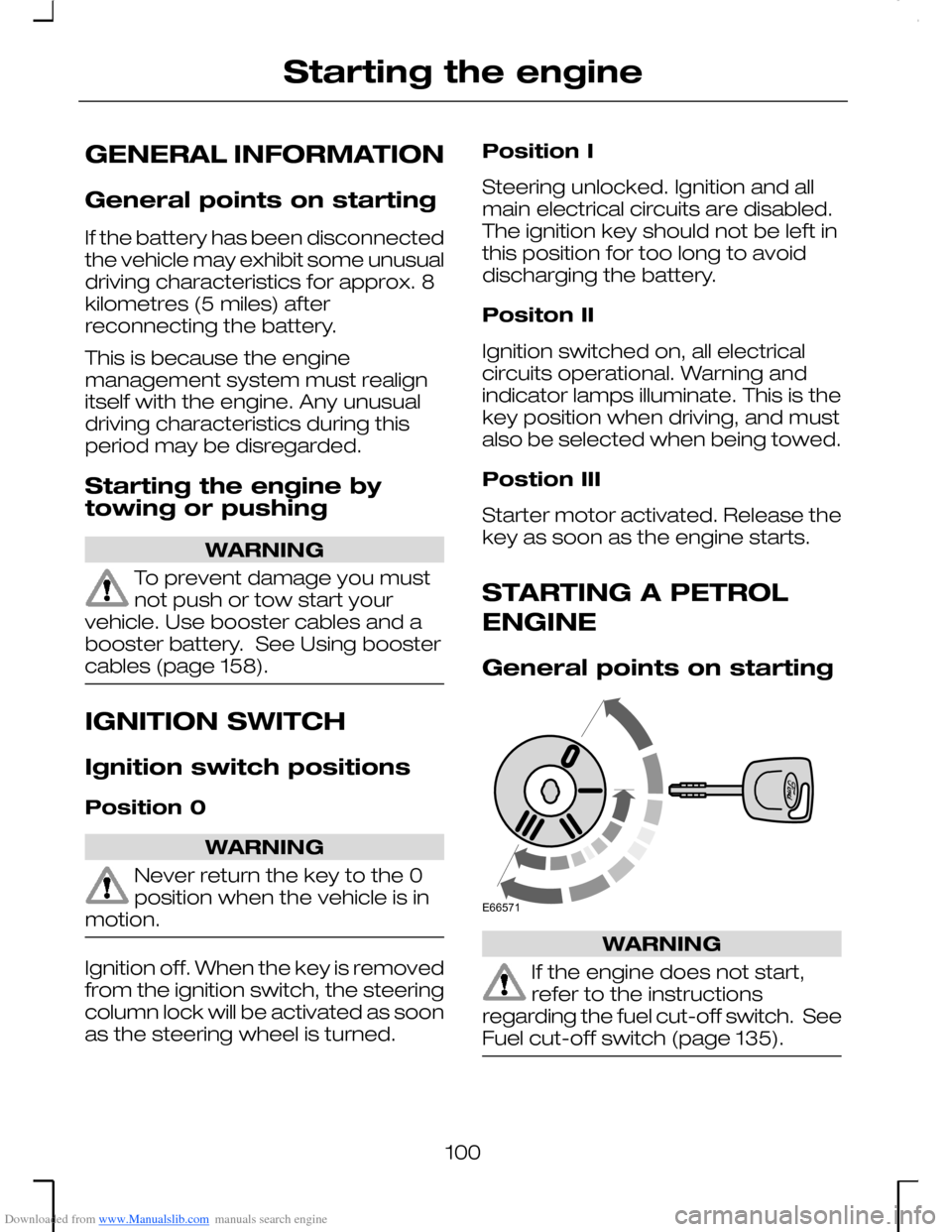
Downloaded from www.Manualslib.com manuals search engine GENERAL INFORMATION
General points on starting
If the battery has been disconnectedthe vehicle may exhibit some unusualdriving characteristics for approx. 8kilometres (5 miles) afterreconnecting the battery.
This is because the enginemanagement system must realignitself with the engine. Any unusualdriving characteristics during thisperiod may be disregarded.
Starting the engine bytowing or pushing
WARNING
To prevent damage you mustnot push or tow start yourvehicle. Use booster cables and abooster battery. See Using boostercables (page 158).
IGNITION SWITCH
Ignition switch positions
Position 0
WARNING
Never return the key to the 0position when the vehicle is inmotion.
Ignition off. When the key is removedfrom the ignition switch, the steeringcolumn lock will be activated as soonas the steering wheel is turned.
Position I
Steering unlocked. Ignition and allmain electrical circuits are disabled.The ignition key should not be left inthis position for too long to avoiddischarging the battery.
Positon II
Ignition switched on, all electricalcircuits operational. Warning andindicator lamps illuminate. This is thekey position when driving, and mustalso be selected when being towed.
Postion III
Starter motor activated. Release thekey as soon as the engine starts.
STARTING A PETROL
ENGINE
General points on starting
WARNING
If the engine does not start,refer to the instructionsregarding the fuel cut-off switch. SeeFuel cut-off switch (page 135).
100
Starting the engineE66571
Page 113 of 198
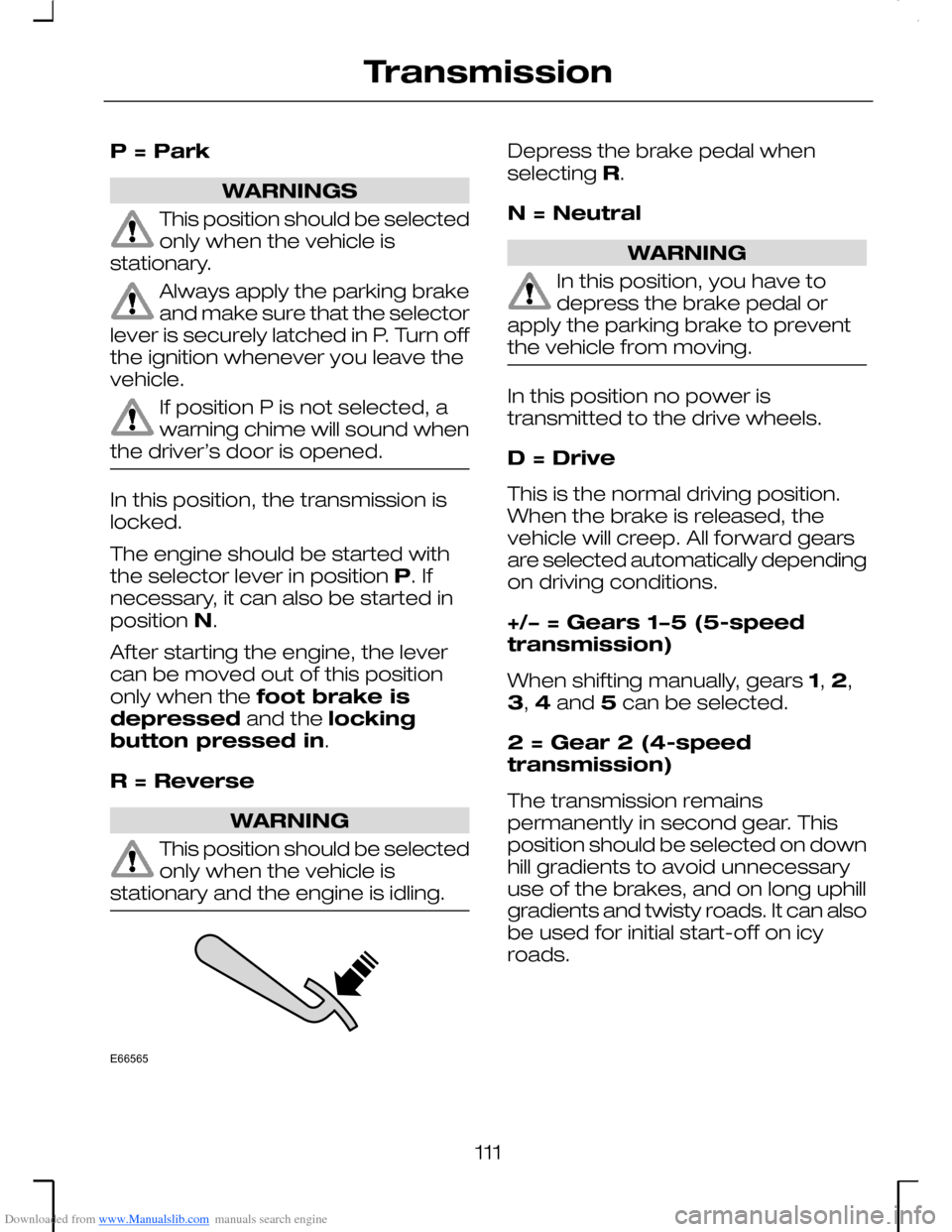
Downloaded from www.Manualslib.com manuals search engine P = Park
WARNINGS
This position should be selectedonly when the vehicle isstationary.
Always apply the parking brakeand make sure that the selectorlever is securely latched in P. Turn offthe ignition whenever you leave thevehicle.
If position P is not selected, awarning chime will sound whenthe driver’s door is opened.
In this position, the transmission islocked.
The engine should be started withthe selector lever in position P. Ifnecessary, it can also be started inposition N.
After starting the engine, the levercan be moved out of this positiononly when the foot brake isdepressed and the lockingbutton pressed in.
R = Reverse
WARNING
This position should be selectedonly when the vehicle isstationary and the engine is idling.
Depress the brake pedal whenselecting R.
N = Neutral
WARNING
In this position, you have todepress the brake pedal orapply the parking brake to preventthe vehicle from moving.
In this position no power istransmitted to the drive wheels.
D = Drive
This is the normal driving position.When the brake is released, thevehicle will creep. All forward gearsare selected automatically dependingon driving conditions.
+/− = Gears 1−5 (5-speedtransmission)
When shifting manually, gears 1, 2,3, 4 and 5 can be selected.
2 = Gear 2 (4-speedtransmission)
The transmission remainspermanently in second gear. Thisposition should be selected on downhill gradients to avoid unnecessaryuse of the brakes, and on long uphillgradients and twisty roads. It can alsobe used for initial start-off on icyroads.
111
TransmissionE66565
Page 114 of 198
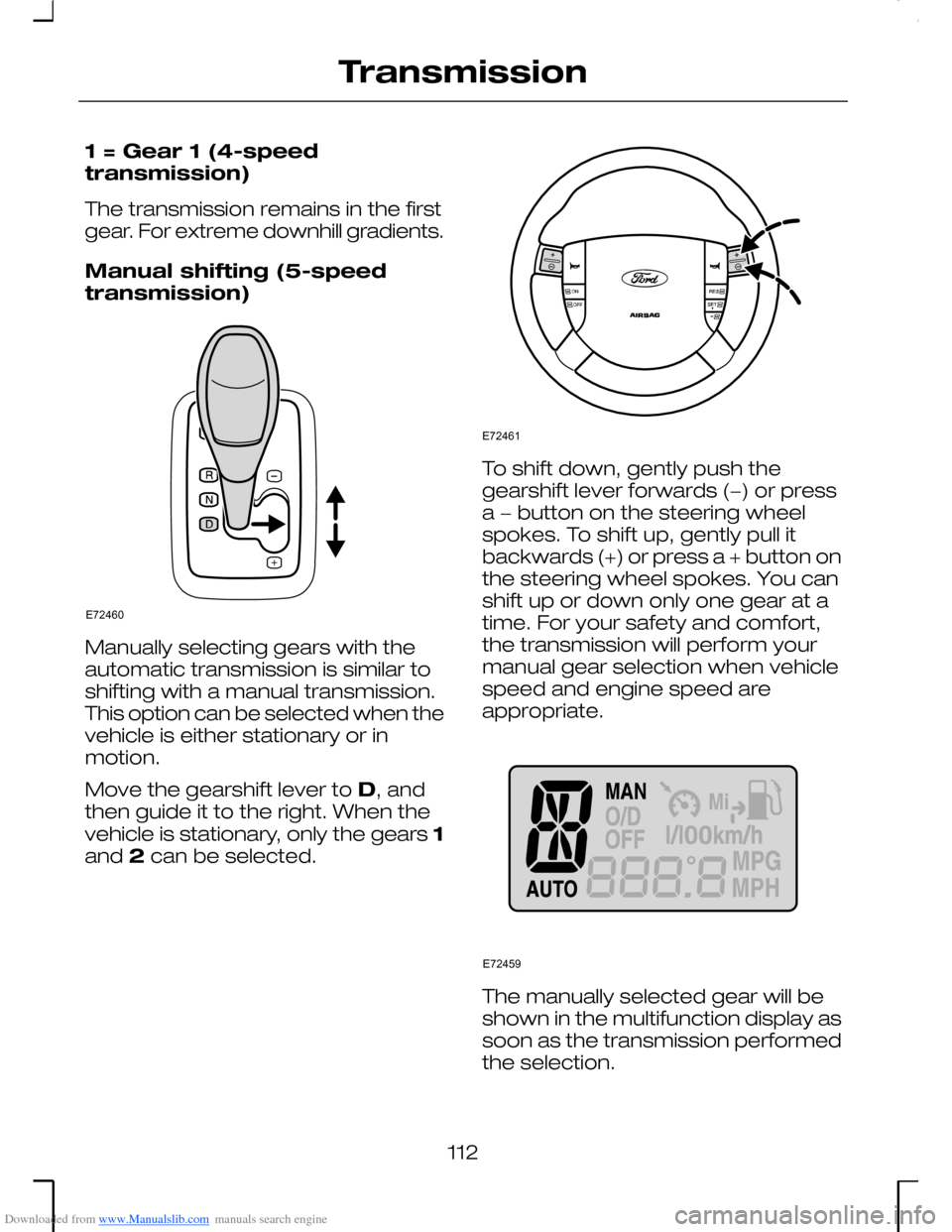
Downloaded from www.Manualslib.com manuals search engine 1 = Gear 1 (4-speedtransmission)
The transmission remains in the firstgear. For extreme downhill gradients.
Manual shifting (5-speedtransmission)
Manually selecting gears with theautomatic transmission is similar toshifting with a manual transmission.This option can be selected when thevehicle is either stationary or inmotion.
Move the gearshift lever to D, andthen guide it to the right. When thevehicle is stationary, only the gears 1and 2 can be selected.
To shift down, gently push thegearshift lever forwards (−) or pressa − button on the steering wheelspokes. To shift up, gently pull itbackwards (+) or press a + button onthe steering wheel spokes. You canshift up or down only one gear at atime. For your safety and comfort,the transmission will perform yourmanual gear selection when vehiclespeed and engine speed areappropriate.
The manually selected gear will beshown in the multifunction display assoon as the transmission performedthe selection.
112
TransmissionE72460 E72461 E72459
Page 116 of 198
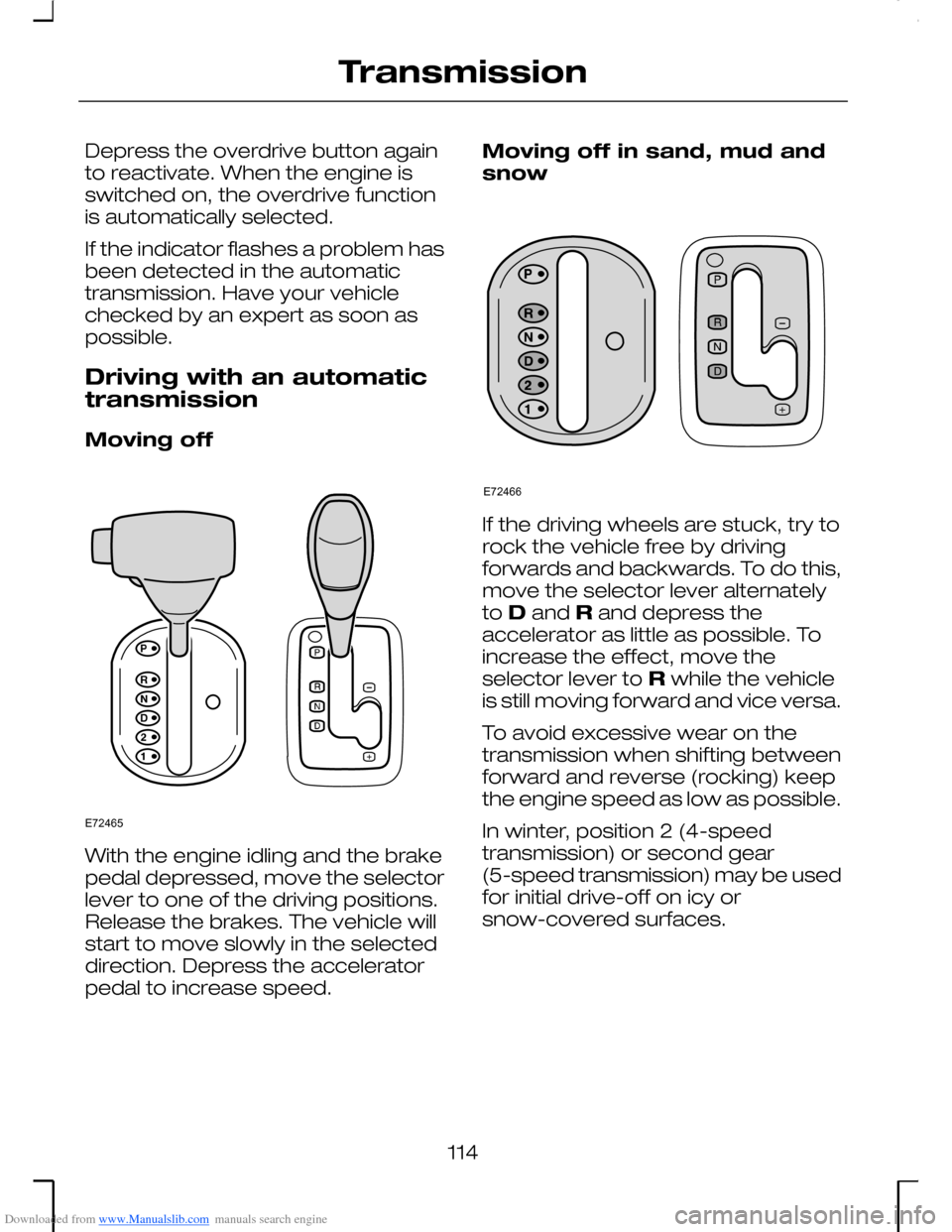
Downloaded from www.Manualslib.com manuals search engine Depress the overdrive button againto reactivate. When the engine isswitched on, the overdrive functionis automatically selected.
If the indicator flashes a problem hasbeen detected in the automatictransmission. Have your vehiclechecked by an expert as soon aspossible.
Driving with an automatictransmission
Moving off
With the engine idling and the brakepedal depressed, move the selectorlever to one of the driving positions.Release the brakes. The vehicle willstart to move slowly in the selecteddirection. Depress the acceleratorpedal to increase speed.
Moving off in sand, mud andsnow
If the driving wheels are stuck, try torock the vehicle free by drivingforwards and backwards. To do this,move the selector lever alternatelyto D and R and depress theaccelerator as little as possible. Toincrease the effect, move theselector lever to R while the vehicleis still moving forward and vice versa.
To avoid excessive wear on thetransmission when shifting betweenforward and reverse (rocking) keepthe engine speed as low as possible.
In winter, position 2 (4-speedtransmission) or second gear(5-speed transmission) may be usedfor initial drive-off on icy orsnow-covered surfaces.
114
TransmissionE72465 E72466
Page 121 of 198
Downloaded from www.Manualslib.com manuals search engine The ABS operates only when thewheels are about to lock. Itsoperation is indicated by a pulsing ofthe brake pedal and full steeringcontrol is retained. Do not releasethe pedal whilst braking.
PARKING BRAKE
All vehicles
WARNING
Vehicles with an automatictransmission should always beleft with the selector lever in positionP.
•Press the foot brake pedal firmly.
•Pull the parking brake lever upsmartly to its fullest extent.
•Do not press the release buttonwhile pulling the lever up.
•If your vehicle is parked on a hilland facing uphill, select first gearand turn the steering wheel awayfrom the kerb.
•If your vehicle is parked on a hilland facing downhill, select reversegear and turn the steering wheeltowards the kerb.
To release the parking brake, pressthe brake pedal firmly, pull the leverup slightly, depress the releasebutton and push the lever down.
119
BrakesE66566 E70430
Page 122 of 198
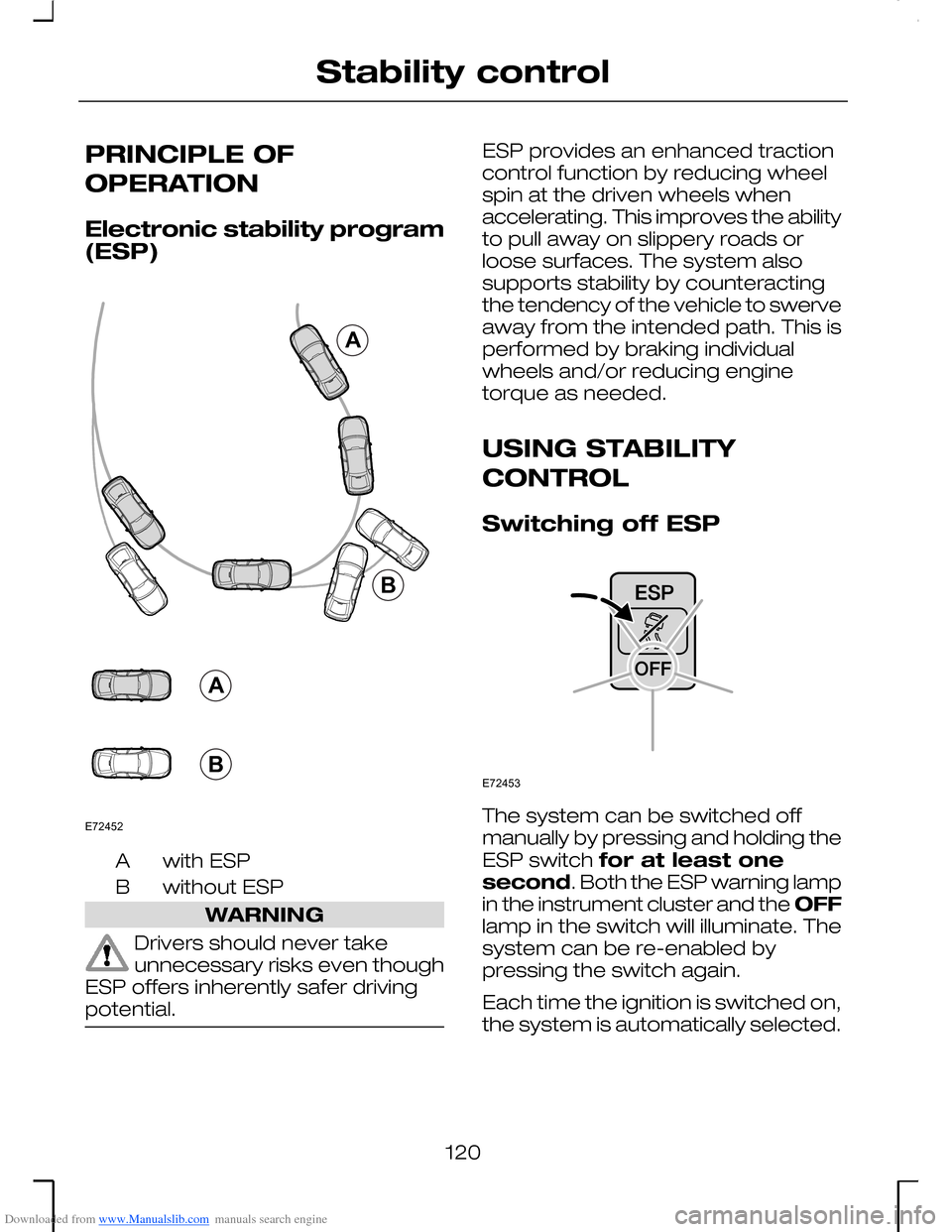
Downloaded from www.Manualslib.com manuals search engine PRINCIPLE OF
OPERATION
Electronic stability program(ESP)
with ESPA
without ESPB
WARNING
Drivers should never takeunnecessary risks even thoughESP offers inherently safer drivingpotential.
ESP provides an enhanced tractioncontrol function by reducing wheelspin at the driven wheels whenaccelerating. This improves the abilityto pull away on slippery roads orloose surfaces. The system alsosupports stability by counteractingthe tendency of the vehicle to swerveaway from the intended path. This isperformed by braking individualwheels and/or reducing enginetorque as needed.
USING STABILITY
CONTROL
Switching off ESP
The system can be switched offmanually by pressing and holding theESP switch for at least onesecond. Both the ESP warning lampin the instrument cluster and the OFFlamp in the switch will illuminate. Thesystem can be re-enabled bypressing the switch again.
Each time the ignition is switched on,the system is automatically selected.
120
Stability controlAABBE72452 E72453
Page 123 of 198
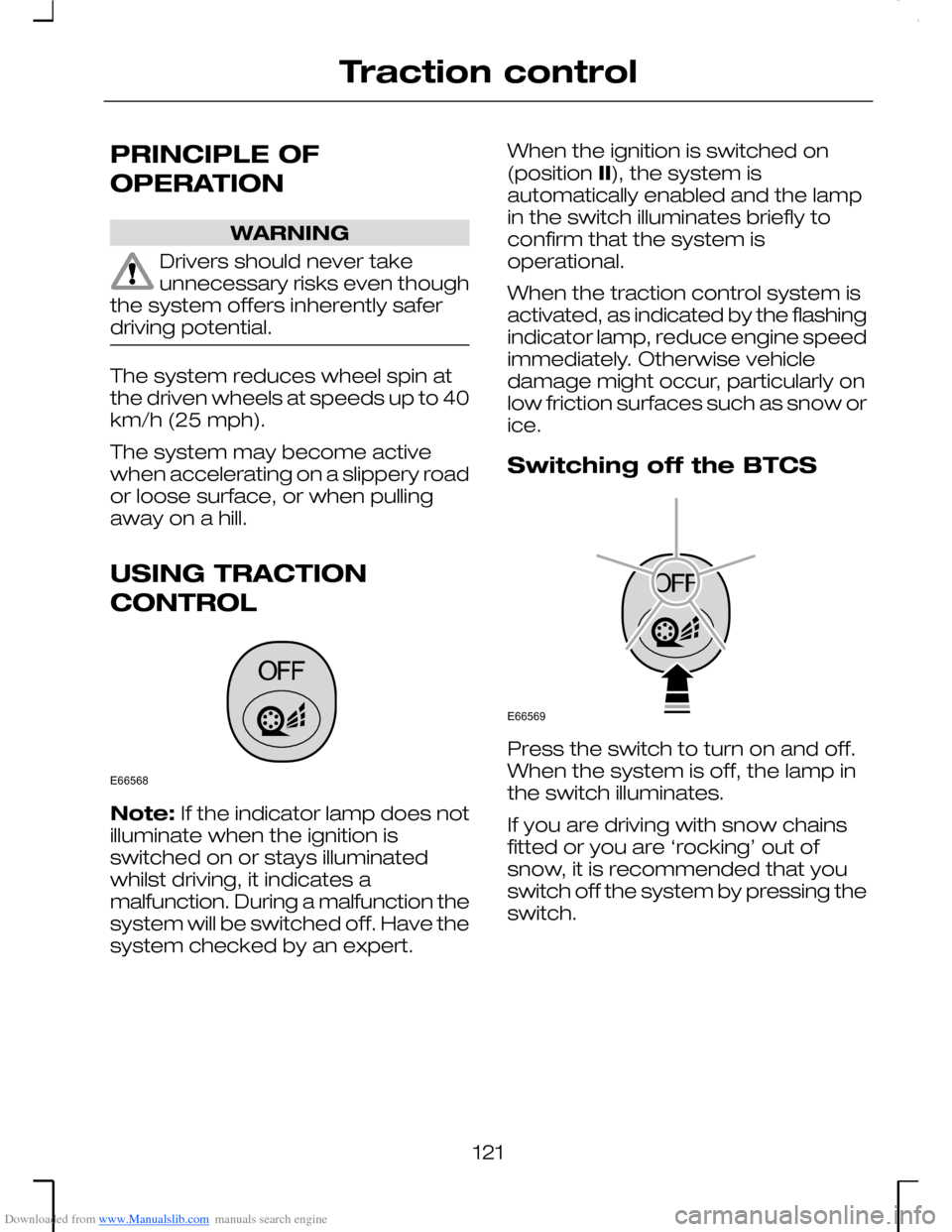
Downloaded from www.Manualslib.com manuals search engine PRINCIPLE OF
OPERATION
WARNING
Drivers should never takeunnecessary risks even thoughthe system offers inherently saferdriving potential.
The system reduces wheel spin atthe driven wheels at speeds up to 40km/h (25 mph).
The system may become activewhen accelerating on a slippery roador loose surface, or when pullingaway on a hill.
USING TRACTION
CONTROL
Note: If the indicator lamp does notilluminate when the ignition isswitched on or stays illuminatedwhilst driving, it indicates amalfunction. During a malfunction thesystem will be switched off. Have thesystem checked by an expert.
When the ignition is switched on(position II), the system isautomatically enabled and the lampin the switch illuminates briefly toconfirm that the system isoperational.
When the traction control system isactivated, as indicated by the flashingindicator lamp, reduce engine speedimmediately. Otherwise vehicledamage might occur, particularly onlow friction surfaces such as snow orice.
Switching off the BTCS
Press the switch to turn on and off.When the system is off, the lamp inthe switch illuminates.
If you are driving with snow chainsfitted or you are ‘rocking’ out ofsnow, it is recommended that youswitch off the system by pressing theswitch.
121
Traction controlE66568 E66569
Page 136 of 198
Downloaded from www.Manualslib.com manuals search engine FIRST AID KIT
4-door and 5-door
Vehicles with a temporaryspare wheel
Storage for a first aid kit is located oneither side of the luggagecompartment.
Vehicles with a full-size sparewheel
A fastening tape to secure a first aidkit is provided on the left side of theluggage compartment.
Estate
Storage for a first aid kit is located onthe left-hand side of the luggagecompartment.
WARNING TRIANGLE
4-door and 5-door
Vehicles with a temporaryspare wheel
Storage for a warning triangle islocated on either side of the luggagecompartment.
Vehicles with a full-size sparewheel
Storage for a warning triangle islocated on the right side of theluggage compartment in a foam trayunder the carpet.
Estate
Storage for a warning triangle islocated on the left-hand side of theluggage compartment.
134
Emergency equipment